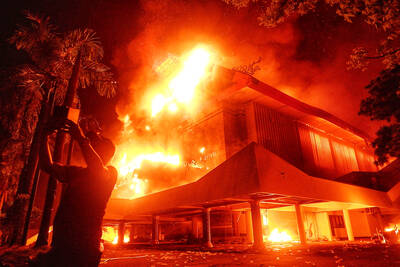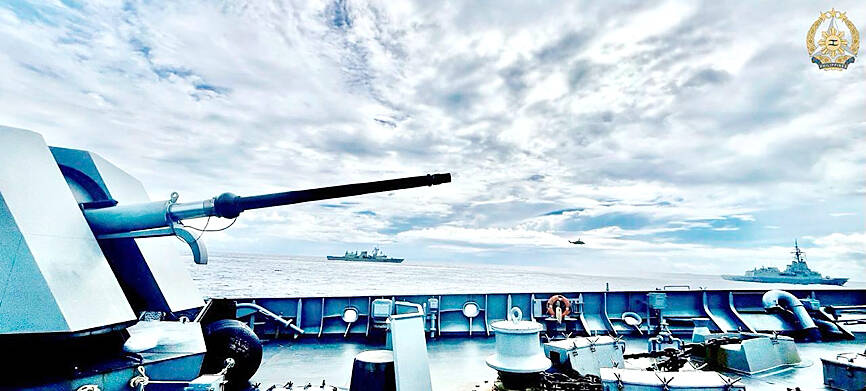With their huge copper vats and open fires, backyard liquor makers have toiled for generations on Philippine coconut farms to distill their equivalent of Russian vodka.
Once considered a lowly peasant’s drink whose potency is said to put other liquors and spirits worldwide in the shade, the lambanog is the Philippine version of coconut arrack also made in Sri Lanka and Indonesia.
“Many have compared it to Russian vodka or English gin, but what sets our lambanog apart is that you don’t get a hangover,” distiller Isabelita Capistrano said.
The family-owned Capistrano Distillery in coconut-rich Tayabas is one of two leading Philippine makers of lambanog, which it sells to the country’s biggest supermarket chain.
“It is a very hard drink. Japanese and South Korean [tourists] especially like it. Americans find it too strong, but smooth,” she said.
However, if drinking it is a challenge, making it is a high-risk pursuit that can lead to the death of those charged with climbing coconut trees to collect the frothy sap that is fermented to produce the drink.
“People have fallen and died or had broken bones,” said Eugenio Andaya, who has been climbing the trees since he was a teenager.
“It is a very difficult job, but I just pray and leave my fate to the Lord,” he said in a recent early morning visit to Tayabas, a sleepy, picturesque rural town about three hours’ drive from Manila.
Workers climb the trees without protective harnesses to prune the coconut flowers before they turn into fruits. The sap is allowed to drip into bamboo receptacles.
Like high-wire performers, the tappers navigate a network of bamboo bridges connecting the trees 9m above the ground, with blades on their waists and bags tightly strapped to their shoulders.
Pruning is mostly done in the afternoon, and the climbers return at dawn to collect the liquid “even before the roosters crow,” Andaya said.
Farmhands then deliver the sap to the distillery in big plastic containers that are carried behind their backs or on pack horses.
The sap is fermented into a local wine called tuba, which if distilled further, yields the colourless lambanog.
Capistrano said the process of distilling the equivalent of coconut vodka was first recorded in Tayabas in the early 19th century.
Founded by Spain in the 1580s as part of its move to Christianize its Asian colony, Tayabas lies in the shadow of Mount Banahaw, a spiritual place where shamans live and where rainwater rushing down the slopes keeps the land fertile.
According to local lore, the first known Tayabas distillery was owned by a Spanish soldier, named Alandy, who settled in the area.
Alandy’s line is now produced by the rival Mallari Distillery, whose owners trace their ancestry to the soldier and who still maintain the original recipe of a drink with a 90 proof grade, which means it contains 45 percent alcohol.
While the Mallari Distillery remains in operation, the Capistrano family said it has taken a lead in promoting the drink abroad.
Lambanog remains a cheap, popular drink across the Philippines. However, official data on how much income it generates domestically remains sketchy, with the beverage sold locally through neighborhood shops that do not remit any taxes or reports. In 2001 the government approached the Mallari and Capistrano houses and 14 other smaller lambanog distillers with a plan to develop the product for export.
It provided packaging expertise, introduced modern bottling operations and sponsored alcohol tasting tours for foreign buyers.
The trade department said the drink had been slowly penetrating the beverage markets in Australia, Japan and Macau.
It faces competition from Sri Lanka in particular, which targets Japan, South Korea and the Maldives with premium blends. Capistrano’s best-seller is lambanog spiked with local wild blackberries called liputi which offer a slightly sweet, tangy taste.
“We want the world to know that lambanog is the official Philippine liquor,” she said.

Australia has announced an agreement with the tiny Pacific nation Nauru enabling it to send hundreds of immigrants to the barren island. The deal affects more than 220 immigrants in Australia, including some convicted of serious crimes. Australian Minister of Home Affairs Tony Burke signed the memorandum of understanding on a visit to Nauru, the government said in a statement on Friday. “It contains undertakings for the proper treatment and long-term residence of people who have no legal right to stay in Australia, to be received in Nauru,” it said. “Australia will provide funding to underpin this arrangement and support Nauru’s long-term economic

‘NEO-NAZIS’: A minister described the rally as ‘spreading hate’ and ‘dividing our communities,’ adding that it had been organized and promoted by far-right groups Thousands of Australians joined anti-immigration rallies across the country yesterday that the center-left government condemned, saying they sought to spread hate and were linked to neo-Nazis. “March for Australia” rallies against immigration were held in Sydney, and other state capitals and regional centers, according to the group’s Web site. “Mass migration has torn at the bonds that held our communities together,” the Web site said. The group posted on X on Saturday that the rallies aimed to do “what the mainstream politicians never have the courage to do: demand an end to mass immigration.” The group also said it was concerned about culture,

ANGER: Unrest worsened after a taxi driver was killed by a police vehicle on Thursday, as protesters set alight government buildings across the nation Protests worsened overnight across major cities of Indonesia, far beyond the capital, Jakarta, as demonstrators defied Indonesian President Prabowo Subianto’s call for calm. The most serious unrest was seen in the eastern city of Makassar, while protests also unfolded in Bandung, Surabaya, Solo and Yogyakarta. By yesterday morning, crowds had dispersed in Jakarta. Troops patrolled the streets with tactical vehicles and helped civilians clear trash, although smoke was still rising in various protest sites. Three people died and five were injured in Makassar when protesters set fire to the regional parliament building during a plenary session on Friday evening, according to

STILL AFLOAT: Satellite images show that a Chinese ship damaged in a collision earlier this month was under repair on Hainan, but Beijing has not commented on the incident Australia, Canada and the Philippines on Wednesday deployed three warships and aircraft for drills against simulated aerial threats off a disputed South China Sea shoal where Chinese forces have used risky maneuvers to try to drive away Manila’s aircraft and ships. The Philippine military said the naval drills east of Scarborough Shoal (Huangyan Island, 黃岩島) were concluded safely, and it did not mention any encounter with China’s coast guard, navy or suspected militia ships, which have been closely guarding the uninhabited fishing atoll off northwestern Philippines for years. Chinese officials did not immediately issue any comment on the naval drills, but they